fuel consumption FIAT MAREA 2000 1.G Workshop Manual
[x] Cancel search | Manufacturer: FIAT, Model Year: 2000, Model line: MAREA, Model: FIAT MAREA 2000 1.GPages: 330
Page 7 of 330

marea-marea vvvttnviiu miruuuCuuu ciilu iwnniCai data
2000 range © Index
00.
page
INTRODUCTION
- Identification data 1
- Weights 3
- Performance - Fuel consumption 4
- Dimensions 5
- Capacities 7
- Product specifications
FL Group 9
TECHNICAL DATA
Engine l^^) lev |^^) 20v
- Specifications 10
- Typical curves 11
- Cylinder block/crankcase and associ
ated components 12
- Auxiliary shaft 17
- Cylinder head and valve gear compo
nents 18
- Timing diagrams 22
- Counter-balance shaft 23
- Lubrication 24
- Cooling system 26
- Fuel feed system 26
- Special tools 27
Engine I^^JJTD
- Specifications 29
- Timing diagrams 30
- Supercharging 31
CLUTCH 32
GEARBOX AND DIFFERENTIAL 33
AUTOMATIC TRANSMISSION DIF
FERENTIAL 35
BRAKING SYSTEM 36
STEERING 39
WHEELS 40
FRONT SUSPENSION 42
REAR SUSPENSION 44
ELECTRICAL EQUIPMENT 46
- Ignition 47
1 - Recharging 48
- Electronic injection/ignition 50
Copyright by Fiat Auto
Page 11 of 330
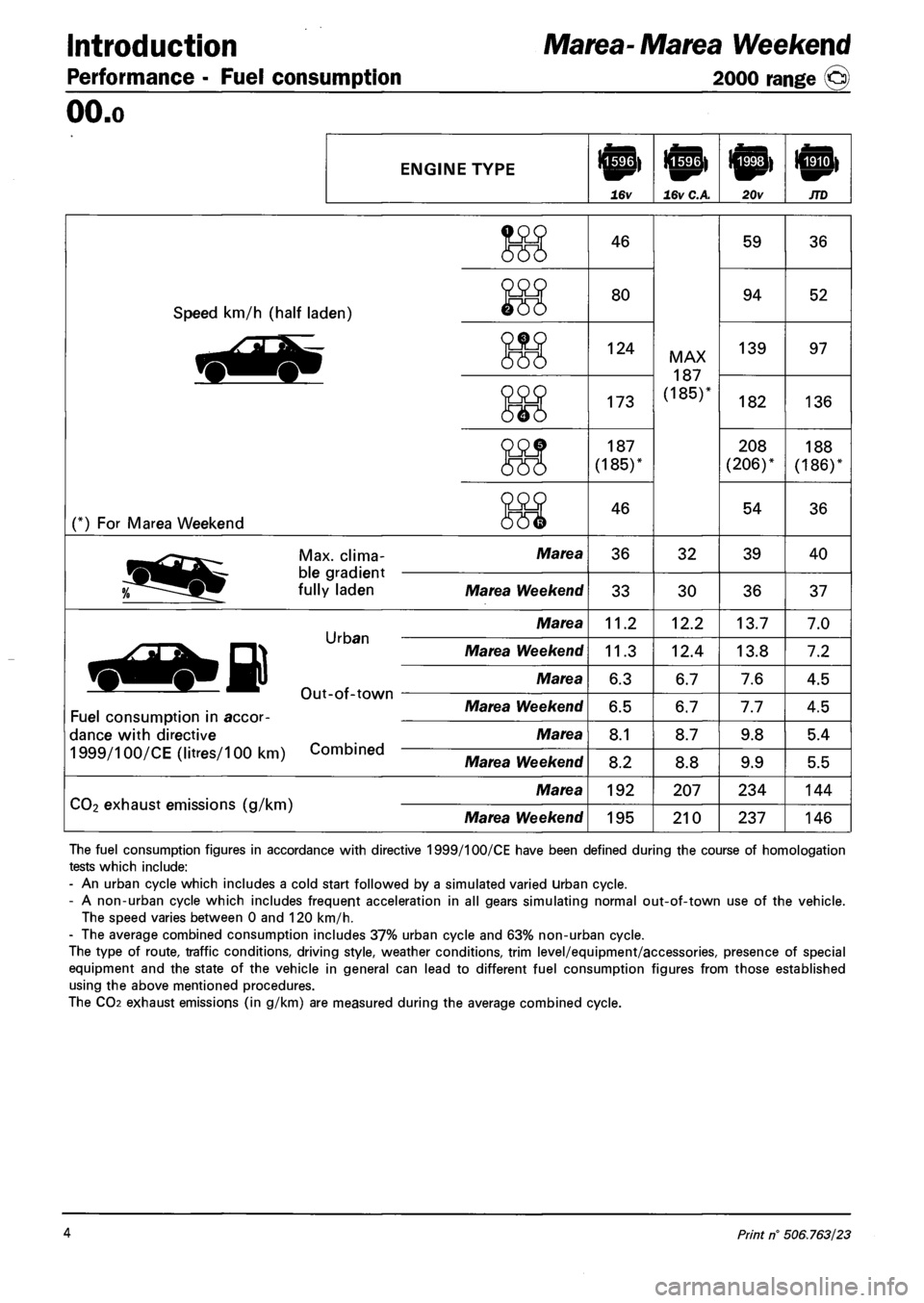
Introduction
Performance - Fuel consumption
Marea-Marea Weekend
2000 range ©
OO.o
ENGINE TYPE
16v 16v C.A 20v JTD
Speed km/h (half laden)
(*) For Marea Weekend
46
80
124
173
187
(185)'
46
MAX
187
(185)*
59
94
139
182
208
(206)*
54
Max. clima-
ble gradient
fully laden
Marea 36 32 39
Marea Weekend 33 30 36
Urban
Out-of-town
Marea 11.2 12.2 13.7
Marea Weekend 11.3 12.4 13.8
Marea 6.3 6.7 7.6
Fuel consumption in accor
dance with directive
1999/100/CE (litres/100 km) Combined
Marea Weekend 6.5 6.7 7.7
Marea 8.1 8.7 9.8
Marea Weekend 8.2 8.8 9.9
CO2 exhaust emissions (g/km)
Marea 192 207 234
Marea Weekend 195 210 237
The fuel consumption figures in accordance with directive 1999/100/CE have been defined during the course of homologation
tests which include:
- An urban cycle which includes a cold start followed by a simulated varied urban cycle.
- A non-urban cycle which includes frequent acceleration in all gears simulating normal out-of-town use of the vehicle.
The speed varies between 0 and 120 km/h.
- The average combined consumption includes 37% urban cycle and 63% non-urban cycle.
The type of route, traffic conditions, driving style, weather conditions, trim level/equipment/accessories, presence of special
equipment and the state of the vehicle in general can lead to different fuel consumption figures from those established
using the above mentioned procedures.
The CO2 exhaust emissions (in g/km) are measured during the average combined cycle.
4 Print n° 506.763/23
Page 60 of 330

Marengo^™ Introduction and technical data
2000 range Index
oo.
page
INTRODUCTION
- Identification data 1
- Dimensions 1
- Weights 2
- Performance 2
- Fuel consumption 2
TECHNICAL DATA
- Front suspension 3
- Rear suspension 3
NOTE
This section gives technical data for the Fiat Marengo 2000 range equipped with a 1910 JTD EC F3 en
gine. For further information, see the Fiat Marea - Fiat Marea Weekend manual publication no. 506.763
and subsequent updates
Copyright by Fiat Auto
Page 62 of 330
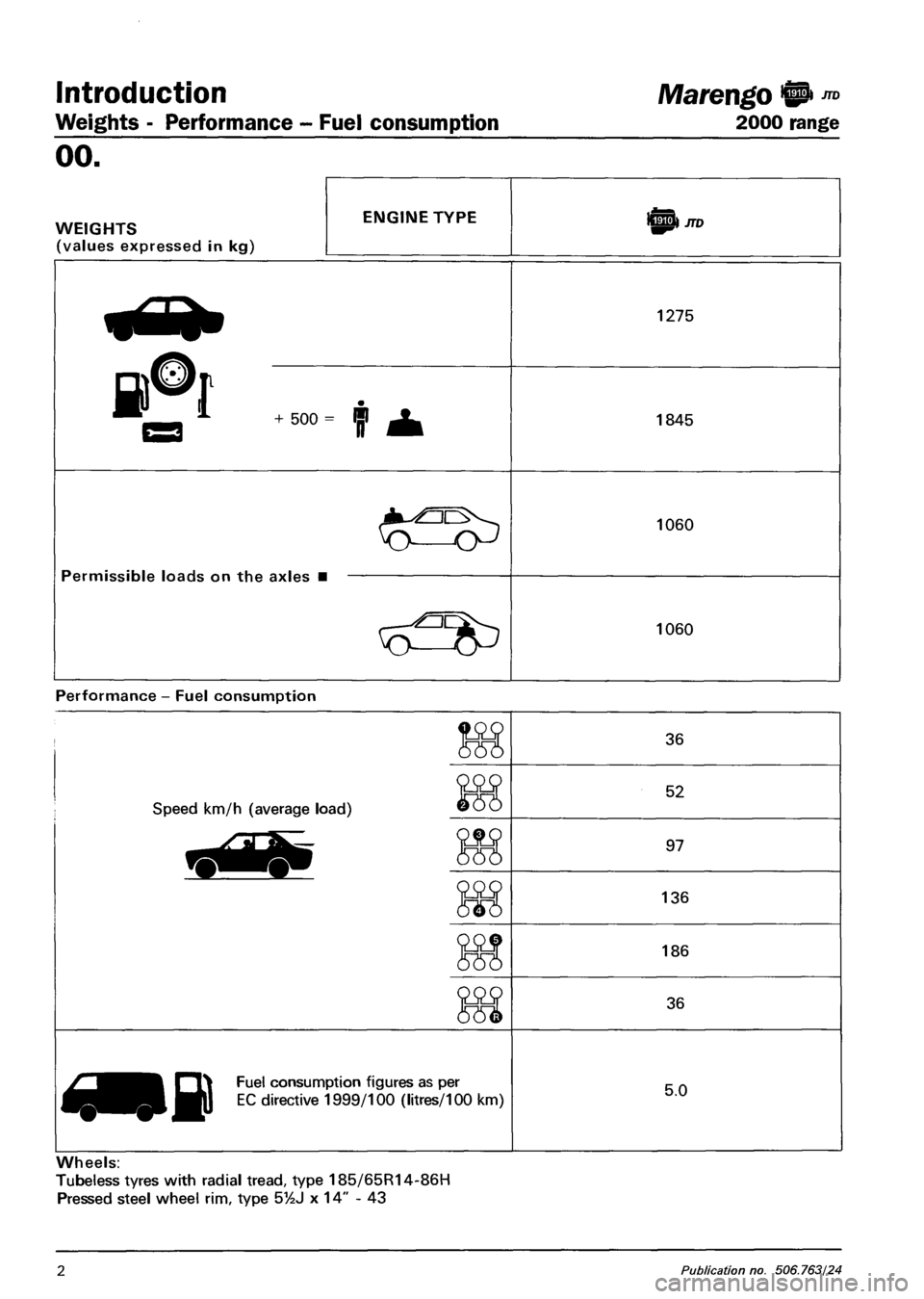
Introduction
Weights - Performance - Fuel consumption
Marengo ® ™
2000 range
oo.
WEIGHTS
(values expressed in kg)
ENGINE TYPE IE®! JTD
1275
1845
Permissible loads on the axles •
1060
Permissible loads on the axles •
1060
Performance - Fuel consumption
36
Speed km/h (average load) ^5^)
52
97
136
186
36
^^j^^^^B PT^ Fuel consumption figures as per
Wy EC directive 1999/100 (litres/100 km)
5.0
Wheels:
Tubeless tyres with radial tread, type 185/65R14-86H
Pressed steel wheel rim, type 5%J x 14" - 43
2 Publication no. 506.763/24
Page 65 of 330
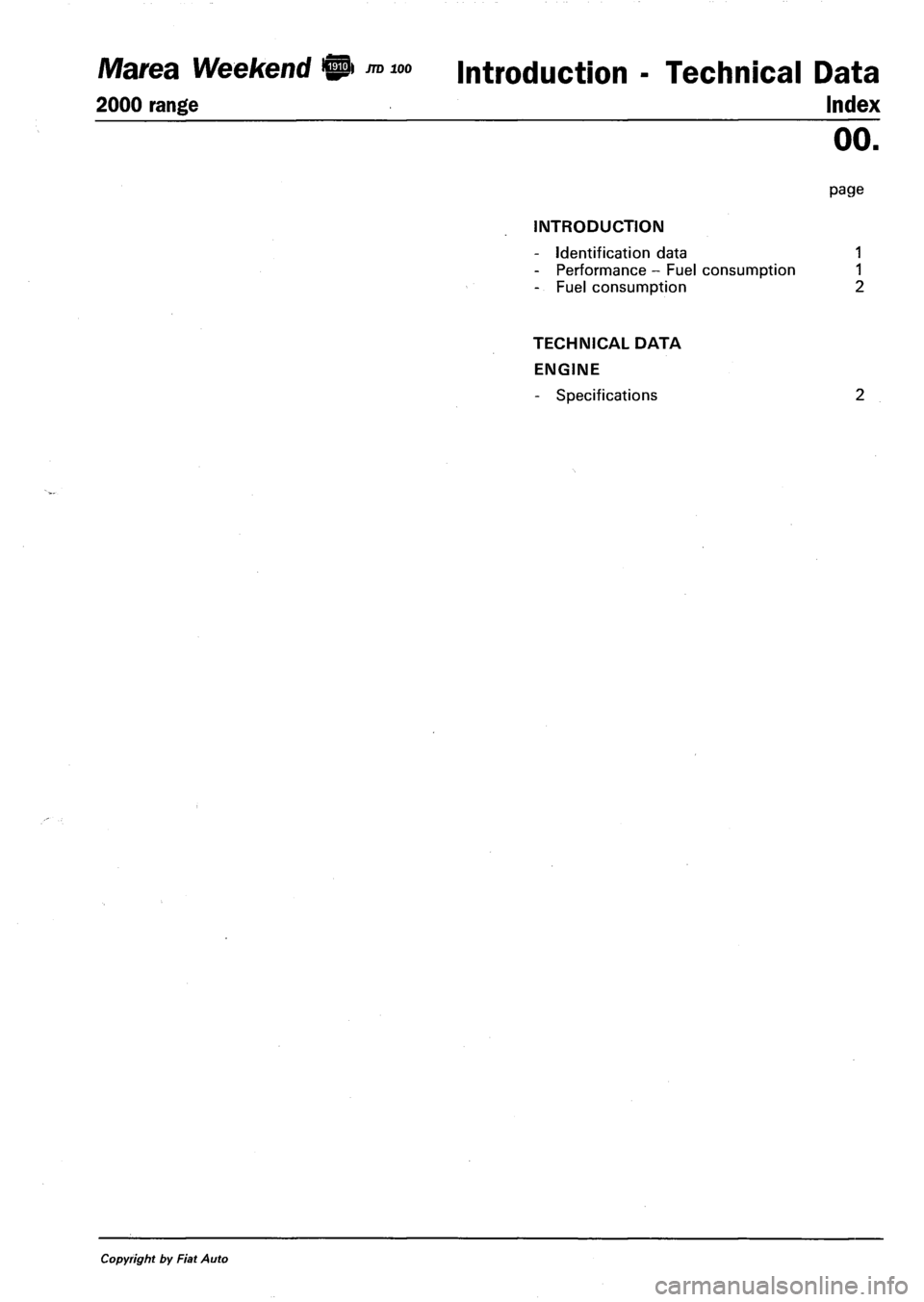
Marea Weekend 9 ™*» Introduction - Technical Data
2000 range Index
00.
page
INTRODUCTION
- Identification data 1
- Performance - Fuel consumption 1
- Fuel consumption 2
TECHNICAL DATA
ENGINE
- Specifications 2
Copyright by Fiat Auto
Page 66 of 330
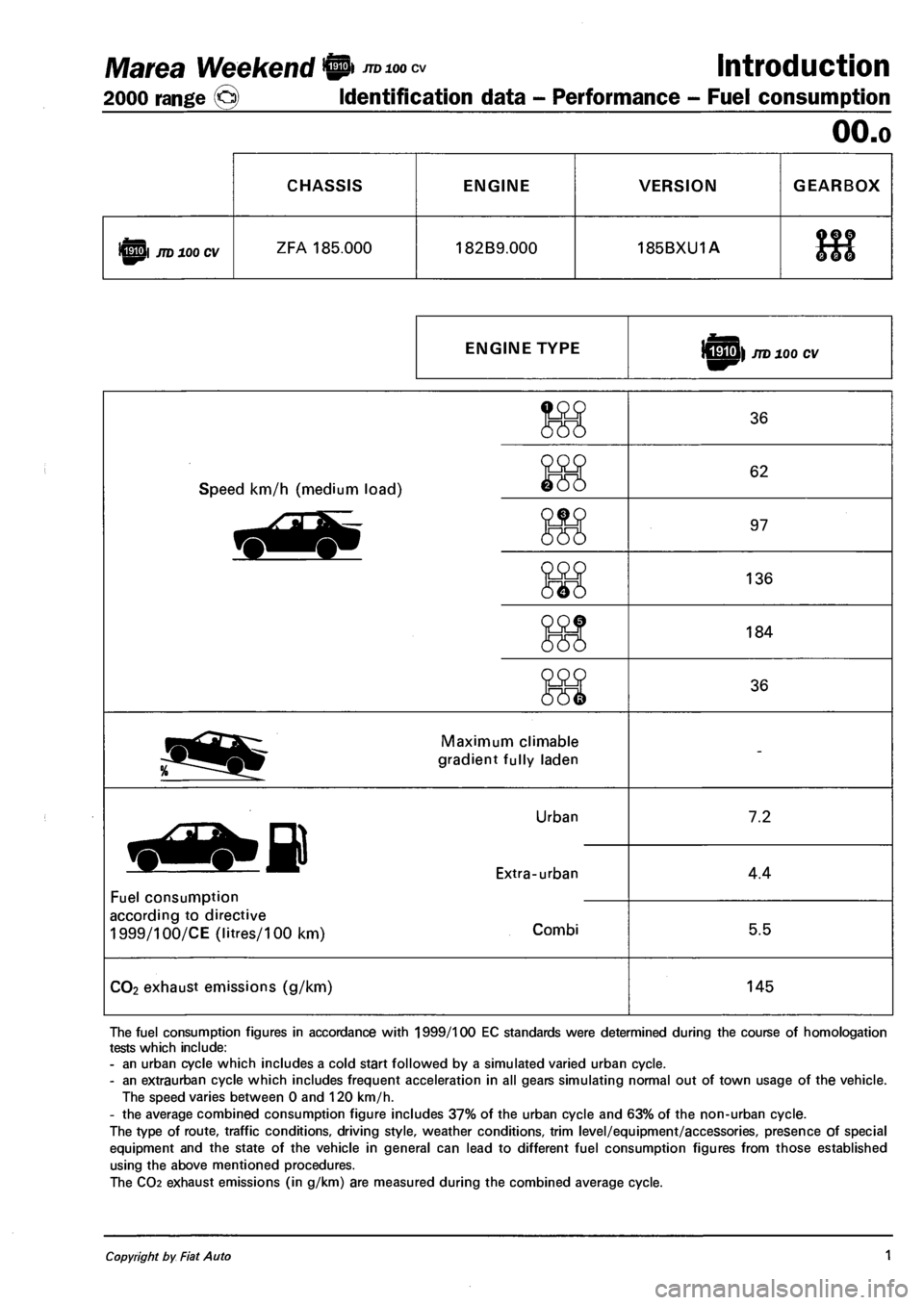
Marea Weekend 9 mnoocv Introduction
2000 range @> Identification data - Performance - Fuel consumption
OO.o
CHASSIS ENGINE VERSION GEARBOX
iQpl JTD 100 CV ZFA 185.000 182B9.000 185BXU1A 9f ?
666
ENGINE TYPE sHU) JTD 100 CV
Speed km/h (medium load)
36
62
97
136
184
36
Maximum climable
gradient fully laden
Fuel consumption
according to directive
1999/100/CE (litres/100 km)
Urban
Extra-urban
Combi
7.2
4.4
5.5
CO2 exhaust emissions (g/km) 145
The fuel consumption figures in accordance with 1999/100 EC standards were determined during the course of homologation
tests which include:
- an urban cycle which includes a cold start followed by a simulated varied urban cycle.
- an extraurban cycle which includes frequent acceleration in all gears simulating normal out of town usage of the vehicle.
The speed varies between 0 and 120 km/h.
- the average combined consumption figure includes 37% of the urban cycle and 63% of the non-urban cycle.
The type of route, traffic conditions, driving style, weather conditions, trim level/equipment/accessories, presence of special
equipment and the state of the vehicle in general can lead to different fuel consumption figures from those established
using the above mentioned procedures.
The CO2 exhaust emissions (in g/km) are measured during the combined average cycle.
Copyright by Fiat Auto 1
Page 87 of 330
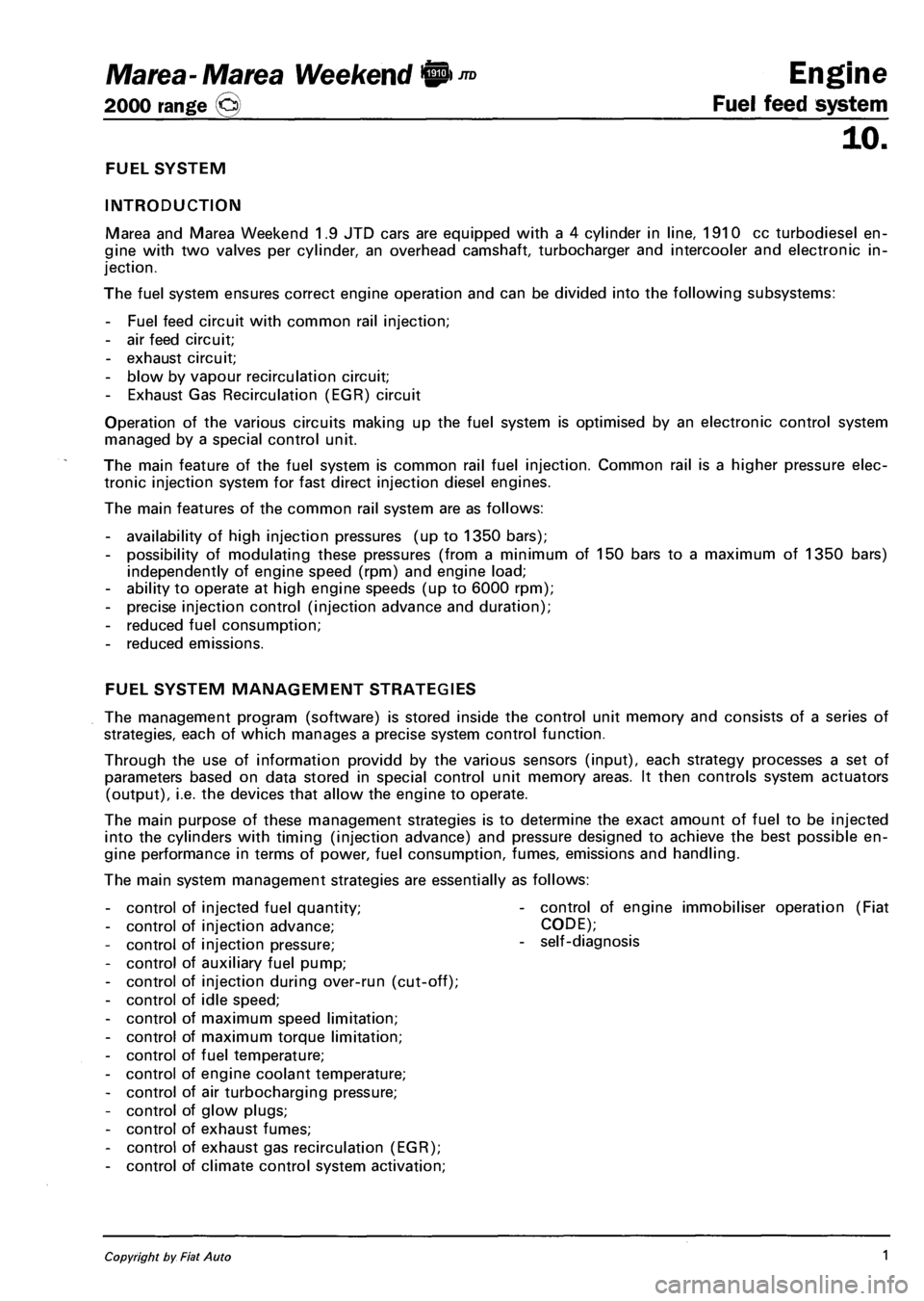
Marea- Marea Weekend © ™ Engine
2000 range Q Fuel feed system
10.
FUEL SYSTEM
INTRODUCTION
Marea and Marea Weekend 1.9 JTD cars are equipped with a 4 cylinder in line, 1910 cc turbodiesel en
gine with two valves per cylinder, an overhead camshaft, turbocharger and intercooler and electronic in
jection.
The fuel system ensures correct engine operation and can be divided into the following subsystems:
- Fuel feed circuit with common rail injection;
- air feed circuit;
- exhaust circuit;
- blow by vapour recirculation circuit;
- Exhaust Gas Recirculation (EGR) circuit
Operation of the various circuits making up the fuel system is optimised by an electronic control system
managed by a special control unit.
The main feature of the fuel system is common rail fuel injection. Common rail is a higher pressure elec
tronic injection system for fast direct injection diesel engines.
The main features of the common rail system are as follows:
- availability of high injection pressures (up to 1350 bars);
- possibility of modulating these pressures (from a minimum of 150 bars to a maximum of 1350 bars)
independently of engine speed (rpm) and engine load;
- ability to operate at high engine speeds (up to 6000 rpm);
- precise injection control (injection advance and duration);
- reduced fuel consumption;
- reduced emissions.
FUEL SYSTEM MANAGEMENT STRATEGIES
The management program (software) is stored inside the control unit memory and consists of a series of
strategies, each of which manages a precise system control function.
Through the use of information providd by the various sensors (input), each strategy processes a set of
parameters based on data stored in special control unit memory areas. It then controls system actuators
(output), i.e. the devices that allow the engine to operate.
The main purpose of these management strategies is to determine the exact amount of fuel to be injected
into the cylinders with timing (injection advance) and pressure designed to achieve the best possible en
gine performance in terms of power, fuel consumption, fumes, emissions and handling.
The main system management strategies are essentially as follows:
contro
contro
contro
contro
contro
contro
contro
contro
contro
contro
contro
contro
contro
contro
contro
of injected fuel quantity;
of injection advance;
of injection pressure;
of auxiliary fuel pump;
of injection during over-run (cut-off);
of idle speed;
of maximum speed limitation;
of maximum torque limitation;
of fuel temperature;
of engine coolant temperature;
of air turbocharging pressure;
of glow plugs;
of exhaust fumes;
of exhaust gas recirculation (EGR);
of climate control system activation;
control of engine immobiliser operation (Fiat
CODE);
self-diagnosis
Copyright by Fiat Auto 1
Page 107 of 330

Marea- Marea Weekend <§l ™
2000 range ©
Engine
Fuel feed system
TZZZZZZZZZZZZZZZZZZb
TZZZZZZZZZZZZZZ*
10.
MULTIFUNCTION VALVE
The multifunction valve is located on the fuel
tank and performs the following functions:
- tank pressurisation
- ventilation
- seal if the car rolls over
Tank pressurisation
Tank pressurisation is maintained at a level be
tween 55 and 75 mbars by means of a valve
mounted on a sealing rim.
The valve is supported by a steel plate and held in place by a spring.
When tank pressure exceeds a specified level, it overcomes spring resistance and allows the valve to rise
so that vapours can flow out.
When the pressure returns to within specified limits, the valve closes again
Ventilation
Under certain car service conditions, a vacuum may build up in the tank due to the effect of:
- heat changes;
- fuel consumption
in this case, the valve's function is to make up pressure inside the tank by letting air into the tank.
If this function is not performed correctly, the car may judder or stall due to difficulties in supplying the
pump.
Seal if the car rolls over
The roll-over function prevents fuel emerging from the tank if the car rolls over or tilts to a great extent.
During normal car operation (bends, acceleration, braking etc.), the fuel slops about and may emerge.
The highly-sensitive roll-over valve prevents this happening.
DELIVERY MANIFOLD (RAIL)
The delivery manifold (rail) is fitted to the cylinder head on the intake side.
Its volume damps fuel pressure fluctuations due mainly to:
- operation of the pressure pump;
- injector opening.
A fuel pressure sensor is fitted in the middle of the delivery manifold.
Hydraulic connections (high pressure) are via special steel pipes.
Copyright by Fiat Auto 21